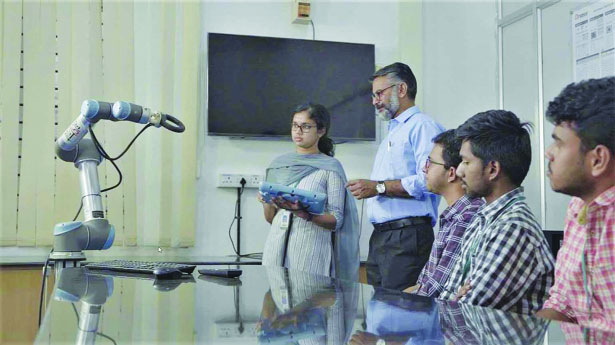Collaborative robots, or cobots, are being introduced worldwide to shape the present and future of students pursuing robotics. Pradeep David tells you how they are different from the conventional robots
As per a report of 2020 by India Brand Equity Foundation (IBEF), India has the world’s largest population in the age range of five-24 years. With the youth comprising the very future of India, it is only wise for the country to steer them in the right direction while honing their talent to prepare them for the careers they wish to pursue. Undeniably, this can only be achieved by providing them with a strong, holistic education, complete with the appropriate resources, tools, and exposure.
It is no secret that India is especially renowned for its education in engineering, mechanics, and technology. Robotics, especially, is witnessing increased interest. While robotics has made its way as a driving force in the education of more developed countries, India’s educational institutes are still not up to the mark, especially considering how imperative it is for universities to provide the right exposure to students, prepping them to be industry-ready professionals. With this in mind, collaborative robots, or cobots, are being introduced worldwide to shape the present and future of students pursuing robotics. Our country is still at a nascent stage of embracing this technology, as a 2018 report by the International Federation of Robotics (IFR) states that the country has only about three robots per every 10,000 workers, in contrast to developed countries such as South Korea, which has an average of 710 robots per 10,000 workers. It is time to change those numbers and welcome cobots into the world of educational institutions to prepare students for the fourth industrial revolution.
Built on the concept of Human-Robot Collaboration (a key tenet of Industry 4.0), cobots are a niche, new type of robots. Unlike conventional fenced robots, they have advanced safety features, including a protective stop that is enabled when an object obstructs its path. This makes them safe to work alongside humans without the need for any cumbersome caging or fencing (subject to risk assessment). This is in contrast to their unsafe, industrial robot predecessors, which require a large amount of space to be fenced off to operate autonomously, as well as programming expertise.
Cobots contribute to creating a robotic lab of international repute along with providing the students with all the ingredients at one place. The collaborative technology is deemed fit for the university as cobots are not just user-friendly but also easy to set-up and customise. They enable customisation with their open-source platform, making it ideal for students to experiment with different programmes, and even create their own applications.
Slowly but surely, we see that universities across India are turning to incorporate collaborative robots into their curriculum, investing in the technology to facilitate an interactive association between students and technology. By creating a stimulating environment that shapes industry-ready students, cobots empower today’s youth to become aware of technologically advanced solutions that can be used by large and small manufacturers alike to place India on the map as a manufacturing hub of global standards.
The writer is General Manager, South Asia, Universal Robots


























